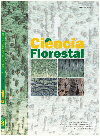
|
Ciência Florestal
Centro de Pesquisas Florestais - CEPEF, Departamento de Ciências Florestais - DCFL, Programa de Pós Graduação em Engenharia Florestal - PPGEF
ISSN: 0103-9954
EISSN: 0103-9954
Vol. 27, No. 3, 2017, pp. 767-782
|
 Bioline Code: cf17063
Bioline Code: cf17063
Full paper language: Spanish
Document type: Research Article
Document available free of charge
|
|
|
Ciência Florestal, Vol. 27, No. 3, 2017, pp. 767-782
| es |
MANEJO DE RESIDUOS DE Eucalyptus grandis  Hill ex Maiden EN SITIOS CONTRASTANTES Hill ex Maiden EN SITIOS CONTRASTANTES
Lupi, Ana Maria; Boca, Teresa; Garcia, Maria De Los Angeles; Diaz, Diana & Ingaramo, Luciana
Resumen
En la región NE de Argentina existe poca información sobre el impacto que tienen las diferentes alternativas
de manejo de residuos de la cosecha forestal sobre las propiedades edáficas. En este estudio se analizó el
efecto a corto plazo de sistemas de manejo de residuos de la cosecha de Eucalyptus grandis Hill ex Maiden,
sobre la concentración del carbono orgánico total del suelo (COT) y la fracción particulada (COP), su estado
estructural y la conductividad hidráulica saturada. El estudio se desarrolló en dos sitios de la Provincia de
Entre Ríos, Argentina, en un suelo Aquic Hapluderts (S1) y en un Fluventic Hapludolls (S2). Se aplicaron los
siguientes tratamientos: 1. Extracción total de residuos (ER), 2. Conservación de residuos (CR), 3. Quema
de residuos-testigo (QR), 4. Doble adición de residuos (DAR). El muestreo de suelos en las profundidades
0-5 cm y 5-10 cm se realizó a los 18 (S1) y a los 22 (S2) meses de aplicar los tratamientos. En el corto
plazo, el efecto de los tratamientos dependió del tipo de suelo y de la variable analizada. Los contrastes
más importantes se debieron al efecto de las características intrínsecas del suelo sobre el tamaño de los
agregados y la conductividad hidráulica saturada. La conservación de residuos no aumentó la concentración
de COT ni modificó la calidad de la materia orgánica medida a partir de COP. El suelo Aquic Hapluderts
presentó agregados más grandes, más estables y una mayor Ksat en comparación con el Fluventic Hapludolls.
En el Aquic Hapluderts se observó una mayor conductividad hidráulica saturada en los tratamientos con
conservación de los residuos (DAR y CR), debido a que la cobertura preservaría el sistema poroso en la
interfase suelo-atmosfera. El Fluventic Hapludolls fue menos estable y los tratamientos no modificaron
significativamente el tamaño de los agregados ni la conductividad hidráulica saturada. Considerando que
las características del sitio tienen efectos de corto plazo y las variables respuesta son afectadas de manera
diferencial es necesario realizar un monitoreo de los parámetros evaluados para analizar las respuestas y las
recomendaciones según el suelo.
Palabras-clave
residuos de cosecha; carbono orgánico del suelo; estabilidad de agregados; conductividad hidráulica saturada.
|
| |
| en |
MANAGEMENT OF RESIDUES FROM Eucalyptus grandis  Hill ex Maiden HARVESTING IN CONTRASTING SITES Hill ex Maiden HARVESTING IN CONTRASTING SITES
Lupi, Ana Maria; Boca, Teresa; Garcia, Maria De Los Angeles; Diaz, Diana & Ingaramo, Luciana
Abstract
In northeastern Argentina, very little is known about the impact of various techniques of management
of residues from forest harvesting on soil properties. We carried out this study in two sites in Entre Ríos
Province (Argentina): post-harvest of Eucalyptus grandis Hill ex Maiden stands in an Aquic Hapludert
(S1) and in a Fluventic Hapludoll (S2). We analyzed the short-term effects of four techniques of residue
management from eucalypt harvesting: extraction of residues (ER), conservation of residues (CR), burning
of residues (BR=control treatment) and conservation of double the regular quantity of residues (CDQR),
which consisted in adding residues from one plot to the adjacent one. Soils were sampled at 0-5 cm and
5-10 cm in 18 (S1) and 22 months (S2) after the techniques of management of residues were applied. Soil
organic carbon (SOC), particulate organic carbon (POC), soil structure and saturated hydraulic conductivity
(Ksat) were determined. Short-term effects of the techniques applied depended on the soil type and on the
soil property analyzed. The main differences between soil properties were due to the effect of soil type on
the size of the aggregates and on Ksat CR caused neither SOC increase nor POC changes, whereas CDQR
and CR increased Ksat in S1, thus suggesting that the surface cover preserves porosity at the soil-atmosphere
interphase. In contrast, S2 showed no significant differences between the effects of the techniques on soil
properties. S1 showed large, stable aggregates and high Ksat, whereas S2 showed less stable structure. Site
characteristics such as soil texture affect the short-term response of soil properties, thus indicating further
evaluations of soil properties are needed to analyze the techniques of management of residue effects and
give management recommendations based on the soil type.
Keywords
harvest residues; soil organic carbon; aggregate stability; saturated hydraulic conductivity
|
| |
© Copyright 2017 - Ciência Florestal
Alternative site location: http://cascavel.ufsm.br/revistas/ojs-2.2.2/index.php/cienciaflorestal/index
|
|
